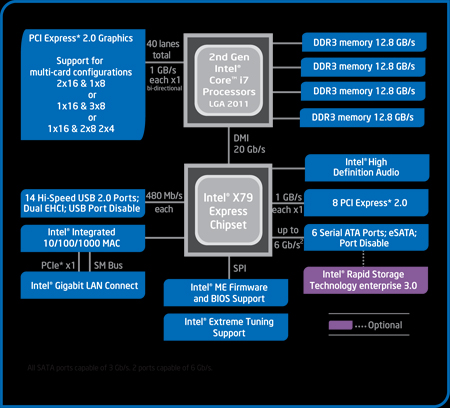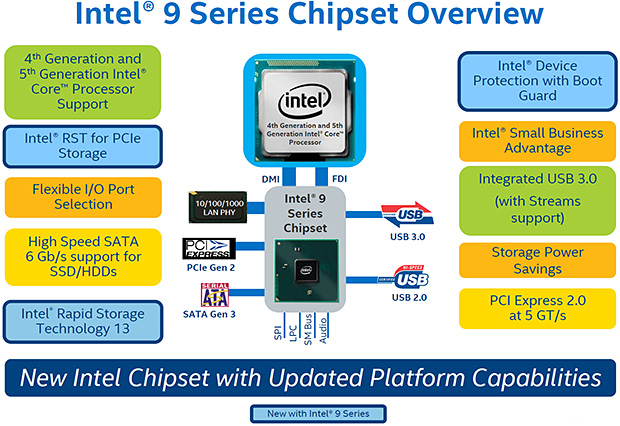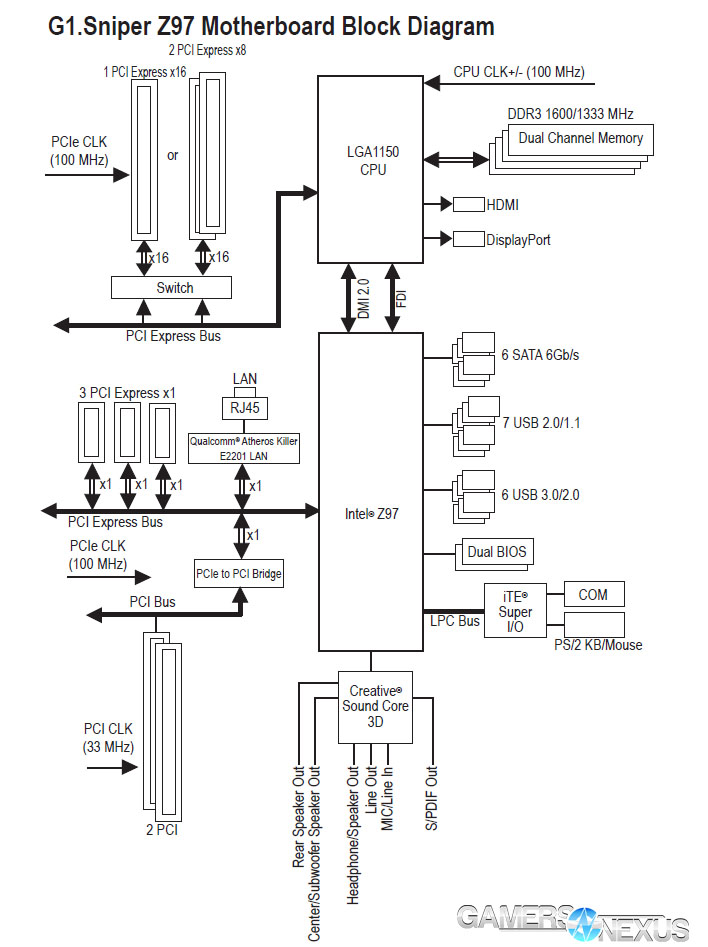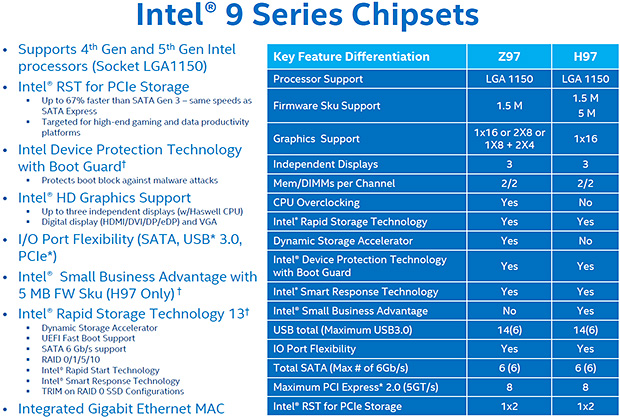Z97 motherboards have been floating around for a little while now -- here's our round-up of them -- but we haven't had a chance to actually look at the Z97 chipset as a product. Z97's immediate accompanying CPU is the Devil's Canyon chip that was announced at GDC, but will later host the 5th Gen Broadwell CPUs. Devil's Canyon is due out shortly, though another Haswell Refresh (i5-4690, others) was recently posted that has seen minimal interest thus far; Broadwell is due out in 4Q14 or later and features a die-shrink to 14nm fab process.
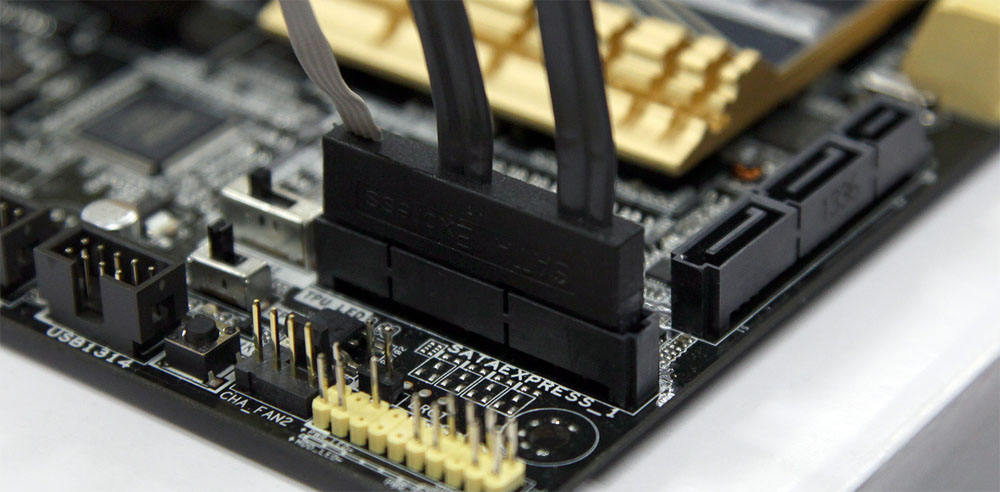 This is a SATA Express connector -- effectively dual SATA ports with additional power/ground.
This is a SATA Express connector -- effectively dual SATA ports with additional power/ground.
Thus far, we know of Intel's Z97 and H97 chipsets and have heard no news of an "H91" or "B95" equivalent from last generation. For this Intel Broadwell 9-series chipset comparison, we'll look strictly at Z97 vs. H97 for gaming and overclocking purposes; the goal of this guide is to help PC builders determine which chipset will perform best for their objectives while remaining price-scaled.
I wrote a similar chipset comparison for AMD FM2/FM2+ chipsets last week.
Intel Naming Scheme: Chipset Branding
I've explained this in-depth in our previous Intel Haswell chipset comparison, but I'll paste it here with some modifications. If you've read our Haswell chipset comparison, you already know Intel's naming scheme.
X- Prefixes: "Enthusiast" Class. This is the big money. X58 took the world by storm with the First Gen i7 chip -- Nehalem -- and has since been followed-up with great success. We're currently on IB-E (Ivy Bridge-E) in enthusiast-class computing, which operates on the X79 chipset (shown below), though Haswell-E is due out shortly on the X99 chipset.
Z- or P- Prefixes: "Performance" Class. Although the P- series is now deprecated, Z- and P-prefixed chipsets are Intel's branding for "performance computing." This is what overclockers and not-quite-enthusiast-class enthusiasts opt for, making most of its demographic dedicated to gamers with an interest in OCing. The performance-series chipsets also make for great render/encoding machines, for those producing YouTube videos or other home footage with some regularity.
H- Prefixes: "Mainstream" computing. The H-series of chipsets is dedicated to non-K SKU CPUs, so it feels most at home when in an HTPC or other "living room" type of computer. Overclockers and enthusiasts should stick to Z and above, but anyone building a pure gaming machine with no interest to overclock at all (and no interest in multi-GPU arrays) should seriously consider H-class chipsets. We'll talk more about why below.
Q- or B- Prefixes: These are for biz-client users. Q-prefixed chips offer options for those working in professional environments that require specific features -- like identity protection -- while B-prefixed options are more budget-friendly, slimmed-down versions.
9-Series Major Chipset Advancements
The 9-series chipsets will still be shipping on LGA1150 socket type platforms, which is a bit odd for Intel. We've historically seen Intel intro a new socket type for every major CPU iteration -- at least for as long as I can remember -- with AMD attempting to hold onto socket types for multiple generations. With this platform, it appears Intel has opted to stick with the existing 1150 pin-out on Haswell into Devil's Canyon and Broadwell. This does not guarantee compatibility between 8-series chipsets and Broadwell (actually, they'll be incompatible), but there will be some cross-compatibility between Devil's Canyon, Haswell, and 8/9-series boards; you'll have to research on a part-by-part basis.
Looking at Intel's chipset overview above, it's clear that most of the immediately noteworthy changes for this update take form in I/O and storage revamps. Intel has added native M.2 and SATA Express support, looking into the future of SSD controllers like Gen3 SandForce, and has updated RST for PCI-e storage. Both of these new-ish interfaces are compatible with SATA and PCI-e devices (NVMe), though board manufacturing will have some dictation of finalized SSD compatibility. PCI-e SSDs will become more prevalent as SandForce Gen3 starts hitting shelves (
The 9-series chipset is dedicating two of eight of its PCI-e Gen2 lanes to the PCI-e SSDs with RST support, relegating PCI-e storage performance to 1GB/s (8Gbps), which is still a significant improvement over SATA III's 6Gbps; after overhead, SATA III tends to hover at around 500-550MB/s maximum throughput. Motherboard manufacturers can decide if they'd like to include aftermarket RAID / storage controllers and drivers that could take advantage of PCI-e Gen3 lanes, but Intel's chipset will natively only reserve Gen2 for storage through RST.
Enthusiasts, professional video editors, and 3D modelers working with ultra-HD resolution textures (4K) and heavy filtering will see the most immediate benefit from PCIe SSDs. Anyone performing raw frame capture with real-time analytics (like FCAT) will also benefit from PCIe SSDs. Those who are strictly gaming will see no worthwhile advantage.
Intel Z97 Chipset Block Diagram on Gigabyte Motherboard
Intel Z97 vs. H97 Chipset Differences
With the storage upgrades out of the way, we can look at CPU compatibility with 9-series chipsets, PCI-e lane allocation, and other Intel proprietary tech on Z97 and H97.
Here's a helpful table from Intel:
Z97 Chipset Spec
Intel's Z-series chipset is still targeted at entry-level enthusiasts, overclockers, and gamers, as always. The chipset bears best compatibility with K-SKU unlocked CPUs by allowing further multiplier bolstering and more granular voltage or clock controls (depends heavily on board manufacturer).
Z97 and H97 are both LGA1150 socket types. Z97's firmware SKU support is listed as 1.5MB. CPU support hosts both 4th Gen and 5th Gen Intel CPUs, but you'll want to check the official CPU compatibility lists for board choices when purchasing. There may be discrepancies.
The chipset hosts enough PCI-e lanes for 1x16 GPU, 2x8 GPUs, or 1x8 + 2x4 GPUs and can output to up to 3 displays natively through the IGP. Discrete video cards will be able to expand upon this, of course. Motherboard manufacturers can offer more lanes by deploying PCI-e multiplexers, like the PLX/PEX chips found on some boards.
Z97 is a dual-channel platform and has standard memory support.
In terms of features, Z97 supports CPU overclocking (noted), IRST, DSA (to eliminate power throttling on PCIe SSDs), "Device Protection Technology with Boot Guard," Intel Smart Response, and IRST for PCIe devices.
Device Protection with Boot Guard is a new low-level tool that will protect against malware that targets the boot sector using TPM. This is more relevant for
14xUSB3.0 lanes are available in total to the board manufacturer with 6xSATA III ports at 6Gbps. 8xPCI-e 2.0 lanes are available, of which 2xPCI-e 2.0 lanes are reserved for RST with PCI-e storage.
H97 Chipset Spec
Moving to H97. This chipset is more heavily targeted at small business / biz-client and budget system builders. Gamers who find themselves uninterested in overclocking would also benefit from H97 purchases to diminish costs. H97 lists the same CPU compatibility, but adds 5MB to the firmware SKU support.
PCI-e lanes allocated for graphics on H97 stops at 1x16, so you won't be going with SLI/CrossFire natively here. The rest of the specs are the same with the exception of:
- CPU overclocking: Support is limited or non-existent. Do not purchase H97 for overclocking and don't waste your K-SKU CPU in an H97 board.
- Intel Small Business Advantage: Allows 5MB firmware SKUs. Uninteresting for mainstream and gaming users.
That's really it for these two chipsets. Nothing too complicated. Let us know if you have any questions below or on the forums!
- Steve "Lelldorianx" Burke.
